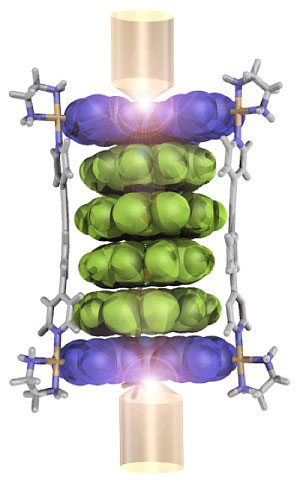| Aug 01, 2011 |
Molecular electronics: conductivity caged
|
|
(Nanowerk News) Like little stacks of pancakes, aromatic molecules like to line up, forming neat columns known as π-stacks. Individual π-stacks, however, are difficult to handle, and pinning down basic properties, particularly whether they act as electrical conductors or insulators, has generated decades of debate. Three research groups in Japan have now teamed up to unravel the electron transfer properties of -stacks, showing that such columns can conduct electrons surprisingly well ("Electron Transport through Single Molecules Comprising Aromatic Stacks Enclosed in Self-Assembled Cages").
|
|
The trick to the discovery was to trap defined π-stacks within molecular cages, an idea recently developed by Makato Fujita and co-workers at the University of Tokyo. The conductivity of the stack was then measured with a scanning tunnelling microscope (STM) using a technique recently pioneered by Manabu Kiguchi and colleagues at the Tokyo Institute of Technology. Finally, the experimental results were confirmed by simulations run by Tomofumi Tada's team back at the University of Tokyo.
|
 |
| Measuring the conductivity of a stack of aromatic molecules (green) trapped within a cage (blue). (© 2011 Wiley-VCH)
|
|
To measure conductance through a -stack, a solution of caged stacks was placed on a gold surface inside the STM. As the conductive tip of the STM was slowly lifted away from that surface, the current at the tip dropped until the gap was wide enough to be bridged by a single stack (see image), at which point the conductivity plateaued. As the tip continued to be pulled away, the gap eventually became too large for the stack to bridge, and the conductivity dropped again. "Our experiments clearly concluded that -stacks are highly electron conductive," says Kiguchi.
|
|
By varying the size of the cage, the researchers could selectively change the height of the stack. As the stack grew taller, from four to six molecules high, its conductivity dropped, but by a surprisingly small degree, says Kiguchi. "We were able to precisely calibrate the electron transport distance, and demonstrate that single-molecule π-stacks exhibit good conductance with only moderate loss with increasing transport length."
|
|
The researchers now plan to study in more detail the nature of electron transport through the -stack in order to make their discovery more useful for practical applications, says Kiguchi. "In the next step, we will investigate the basic character of electron transport through -stacked systems and fabricate more useful -stacks."
|

